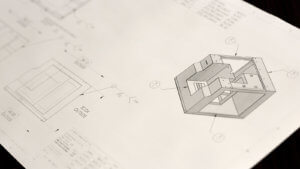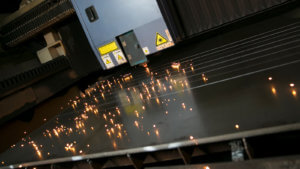Agile Workflow: The Key to Our On-Time Shipping Record
January 04, 2019
 An agile workflow is an essential component of our business. Every movement on our shop floor is carefully choreographed so that each step follows the last in a manner that promotes maximum productivity without the loss of quality. This is one of the biggest reasons we can meet our delivery and on-time shipping requirements of over 99.9%.
An agile workflow is an essential component of our business. Every movement on our shop floor is carefully choreographed so that each step follows the last in a manner that promotes maximum productivity without the loss of quality. This is one of the biggest reasons we can meet our delivery and on-time shipping requirements of over 99.9%.
How does an organization build an agile workflow? In our case, it begins with a rigorous planning protocol, which is completed before the job is sent to the shop floor. Before it’s even an order, in fact. This up-front effort was purposefully designed to pay big dividends during the manufacturing process. We follow the same procedure whether the order is for a Fortune 500 company or the job shop down the street.
Pre-Planning
The process actually begins with a customer need. A Request for Proposal (RFP) given to one of our sales team begins the paper trail. The basic information (including any information that makes the project unique) is entered into a software file. This generates a Quote in Process (QIP) in our system, which will become our formal quote.
Preparing the Quote
Preparing a formal quote is a two-step process. First, we need to know how much raw material will be needed and what it will cost. For this purpose, we create a document known as a Bill of Materials (BOM).
The second step is to determine the operations that will be required to manufacture the part. This could be just about any combination of services we provide, from laser cutting and deburring to plating and coating. Cycle times for each operation are also calculated and included in the QIP. We must also consider the capacity allocation of the equipment involved so the delivery time can be met. This is done with the help of our materials resource planning software.
When these steps are complete, we can put together a formal quote for the customer.
 Planning for Manufacturing
Planning for Manufacturing
You might think once we have the order in hand, we are ready to fabricate the part. Actually, this is just the start. The PO confirms the quantity of parts required and firm delivery dates. This is vital since we back plan all orders from the ship date. With the initial order in hand, we can place our order for all the materials needed from weld nuts to specific powder for powder coating. The customer also delivers any prints, part files they have for the part at this time.
We can’t meet the customer’s standards unless we document what they are. To do this, our engineers and quality team prepare a document called a PPAP (Production Part Approval Process). It is quite detailed and can be 40+ pages long depending on customer requirements. This is part of our advanced planning quality process. We start by re-drawing the prints and making any revisions to allow easier manufacture on our equipment (while maintaining full functionality). Conversions from metric to imperial are also made if required. The idea is to remove any ambiguities that can hold up production before the order hits the shop floor.
The Router File
The BOM is used to create a Router File, the master document that controls the flow of the work through the fabrication line. Each part has its own unique file. It contains PDF drawings, specifications, inspection files and everything else required to make the part. This document will accompany the part through each step of the manufacturing process and is documented internally in our ERP system.
The engineers then create all the programming needed for each machine in the Routing File. They create a 3D model of the part for a virtual inspection before releasing it to the floor. Upon approval, the programming is uploaded into our ERP software, so it can be downloaded to each individual machine for additional processes.
Bringing the Plan to Life
Each part we fabricate follows a unique path through our shop. Like snowflakes, no two are alike. The Router File is the roadmap that guides it through the process. Each step is physically checked off and inspected before the part is sent downstream to the next operation. Time is built in for setup, machine time, quality inspections and move time to the next stage.
As well as providing instructions, the Router File creates a paper trail that can be followed back to track down any logjams that might be holding up progress. Any glitches can be caught early in the process and corrected immediately.
 Manufacturing Snapshot
Manufacturing Snapshot
The first stop in the shop for many jobs is the laser cutter or saw to provide the initial shape to the part. This is where the expertise of our operators comes into play. Their input is vital for a smooth flow. Material handlers stage the raw material by each machine depending on priorities. As steps are completed in one department, the piece is routed to the next. Secondary processes might include welding, press brake, machining or coating. Quality inspections are made between each step. To keep things moving, every plant employee is certified on forklifts. When a part is ready to move on, it moves.
After a final inspection, the product is packaged as specified in detail by the customer. Only then is it ready to load on the truck. Even these stages are determined and put into action by the Router File.
Adjustments on the Fly
Our planning and execution protocols for the parts we make have been fine-tuned to razor-sharp efficiency over the decades. But they are never set in stone. Our customers change their priorities thousands of time each day (literally). These revisions can cause a cascade of change throughout the plant. Without the knowledge of where each part is in the process and the ability to reach out and change direction mid-stream, our best-laid plans would disintegrate into chaos. With the electronic and manual tracking systems built into our operations, we can make modifications and reflow orders without hesitation. This situation is an every day occurrence for us. It is the agility built into our workflow that allows us to react swiftly and keep our on-time promise to all our customers.
If you would like to see this level of preparation and execution applied to your next fabrication project, please contact us. We would be happy to discuss your needs in detail.

